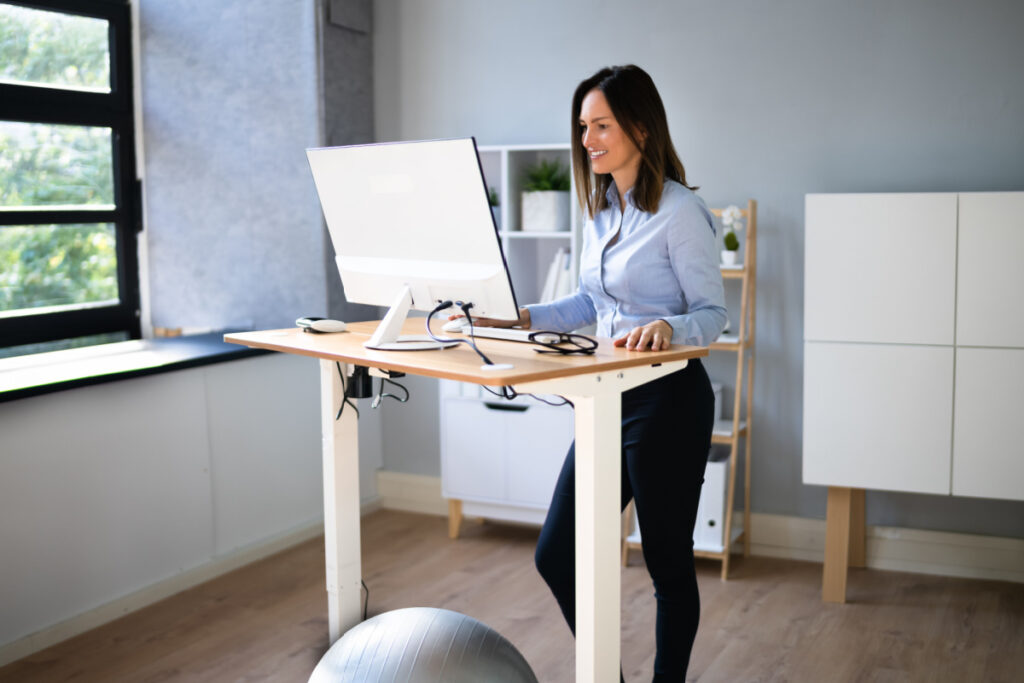Tips for Healthy Posture in Sedentary Jobs
|

Every job has its pros and cons. While sedentary jobs are less physically taxing than jobs that require movement, heavy lifting, or other physical exertion, they can take a toll of their own. If you’re sitting too much—and especially if you’re sitting with poor posture—it can start to have negative effects on your health and comfort.
Whether you’re already struggling with aches and pains from your sedentary job, or are trying to stop the problem before it starts, there’s no time like the present to start practicing healthy posture to help you avoid potentially negative consequences.
Here are some of our best tips for healthy posture in sedentary jobs.
Get the right chair.
More than anything else, the right chair can make all the difference in helping you maintain a good posture while sitting all day long. The basics of a good chair include height adjustment (so you can be at an appropriate height for your desk and computer monitors), good lumbar support for your lower back, armrests, and general comfort. If a brand new chair isn’t in the budget right now, consider getting support cushions to help create a more pleasant sitting experience.
Practice proper sitting position.
It might seem silly to think that you might need to relearn how to sit in a chair, but the reality is, that many people sit in a way that could lead to pain or discomfort later. Here are the basics of sitting correctly.
- – Keep both feet flat on the floor; don’t cross your legs. If necessary, use a stool to make the position more comfortable.
- – Keep your shoulders rolled back and down, and relaxed. Hunching over, or tensing up, can tire your neck and back.
- – Sit up straight. A rounded back will cause aches and pains.
- – Rest your arms on a support, whether on your chair or desk.
- – Keep your knees at or slightly below hip height, and ankles in line with your knees (or slightly in front of them).
- – Keep your weight evenly distributed on your hips (don’t lean to one side or the other).
Set up your workstation with posture in mind.
Your computer monitor should be right at your eye level to help avoid neck strain. Your computer monitor should be about an arm’s length away from your body. You should be able to reach your keyboard comfortably while resting your arms (without stretching them too far forward). If you work with a laptop, consider investing in a separate keyboard and/or monitor, to help you as you’re setting up a more ideal workstation.
Find opportunities to stand.
Staying in the same seated position for more than 30 minutes isn’t recommended. That’s why it’s important to take regular standing breaks. Here are some ideas for working regular standing time into your work day.
- – Set a timer to remind you to stand and stretch.
- – Take a short walk a couple of times a day.
- – Try a standing workstation; alternate between this and your chair throughout the day.
- – Commit to standing/walking during phone calls, whenever possible.
- – Hold a walking one-on-one meeting or brainstorming session.
When you do stand, continue to practice good posture, keeping ears over shoulders, shoulders over hips, and hips over knees, with your weight evenly distributed. If you’ll be standing in one spot (such as at a standing desk), you might want to try using an anti-fatigue mat to make the experience even more comfortable.
Pay attention to your aches and pains.
Everyone’s body will respond differently to sedentary jobs. While some people will feel more strain in their backs, others will feel it in their necks, legs, or even arms. If you notice one particular spot starting to trouble you, don’t ignore it! Instead, think about what you could do to improve comfort for that particular area, whether it’s investing in ergonomic equipment, or reminding yourself to sit in a certain way.
Related: Tips for Asking for a Raise
There are probably some things you love about your sedentary job, but it’s important to make sure you’re still taking care of your physical health, even while you’re sitting still. Use these tips for healthy posture, and enjoy a more comfortable work environment today—and fewer aches and pains tomorrow.
Leave a Reply


